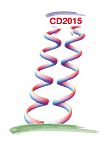Speaker
Alessandro Rizzo
(INFN-Roma2)
Description
The study of the hadronic spectrum is one of the most powerful tools to investigate the mechanism at the basis of quark confinement within hadrons. A precise determination of the spectrum allows not only to asses the properties of the hadrons in their fundamental and excited states, but also to investigate the existence of states resulting from alternative configurations of quarks and gluons configurations, such as the glue-balls, hybrid mesons and many-quarks configurations. The mesonic part of the spectrum can play a central role in this investigation because several of the hybrid mesons are supposed to have different quantum numbers with respect to standard q¯q states, due to the presence of explicit gluonic degrees of freedom. The hybrid mesons are expected to decay into multi-particles final states [1], requiring high performances in terms of rate capability, resolution and acceptance for their detection. New-generation experiments are planned at Jefferson Laboratory (JLAB) for which an unprecedented statistics of events with fully reconstructed kinematics for large multiplicity decays will be available. A wide scientific program that will start in 2016 has been deployed for meson spectrum investigation with the CLAS12 apparatus in Hall B at energies up to 11 GeV. A key role in such program is played by the Forward Tagger [2], which will allow to extend the study of meson electro-production to very low Q2, in a quasi-real photo production kinematical region, where the production of hybrid mesons is expected to be favorite. The analysis required to extract the signal from hybrid states should go beyond the standard Partial Wave analysis techniques and a new analysis framework is being set up through the Haspect Network. The Haspect Network gather people involved into theoretical and experimental hadronic physics all over the world, to investigate and propose new analysis models (such as the Szczepaniak-Pennington model [3]) and new statistical techniques to unfold signal and background. The new analysis framework is being tested using the existing CLAS data and results are projected to the CLAS12 performances, showing that the quest for hybrid exotic mesons is at reach.
References
1. A. Szczepaniak, Phys.Rev. D 59 (1999), p. 034016.
2. The CLAS collaboration, https://www.jlab.org/Hall-B/clas12-web/docs/ft-tdr.2.0.pdf
3 A. Szczepaniak and M.R. Pennington, arXiv:1403.5782v1 [hep-ph] 23 Mar 2014
Primary author
Alessandro Rizzo
(INFN-Roma2)

